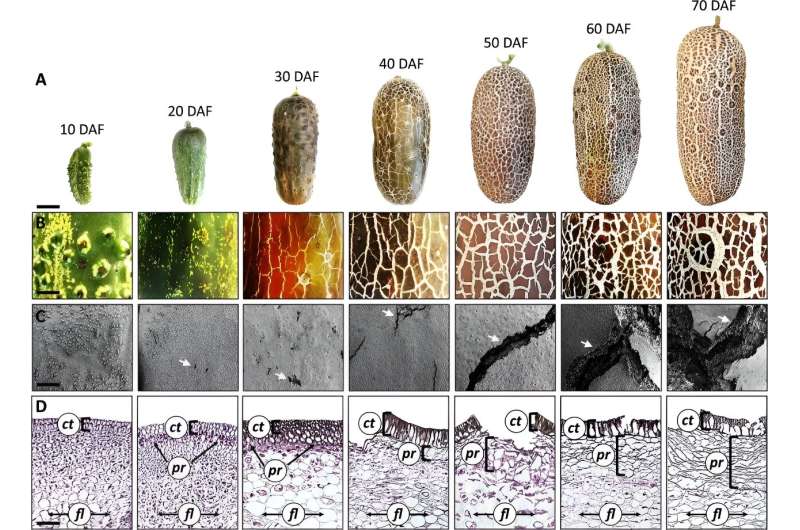This article has been reviewed according to Science X's editorial process and policies. Editors have highlighted the following attributes while ensuring the content's credibility:
fact-checked
peer-reviewed publication
proofread
Unraveling the mystery of lignosuberization: A comprehensive study of periderm formation in Sikkim cucumber fruit skin

In fleshy fruits, periderm tissue often forms on the skin surface as a response to mechanical damage caused following environmental cues or developmental programs, known as lignosuberization, creating a protective, corky matrix.
This process, vital for maintaining skin integrity and protecting against environmental insults, is not fully understood. Previous studies have indicated that the epidermal cell layer alters the fruit's skin chemistry and morphology, involving complex polymers like suberin and lignin. However, the precise biochemical pathways and triggers for lignosuberization remain largely unknown.
Horticulture Research published research titled "The metabolic and proteomic repertoires of periderm tissue in skin of the reticulated Sikkim cucumber fruit."
In this study, researchers employed microscopy, metabolomics, and proteomics to investigate the development of Sikkim cucumber fruit skin, particularly focusing on the cracking phenomenon associated with lignosuberization.
Firstly, researchers performed an investigation of seven stages along the Sikkim cucumber's fruit development at ten-day intervals; from 10 days after fertilization (DAF) to 70 DAF. From 30 DAF until full maturity, the extent of cracking increased, and the fractures widened and deepened. The results also showed that skin cracking in the Sikkim cucumber fruit was related to the formation of a typical wound periderm tissue.
Then, microscopic investigations indicated a large portion of cells that form the wound periderm tissue in the Sikkim cucumber fruit is both lignified and suberized. Further, researchers subjected skin tissue from the seven investigated developmental stages to comparative profiling via GC–MS and UPLC-HRMS.
Periderm tissue formation is principally associated with over-accumulation of suberin components, phenylpropanoids, flavonoids, and ceramides, along with reduced amounts of membrane components and storage lipids. To obtain insight into mechanisms involved in the initiation and regulation of lignosuberized periderms, comparative proteomics profiling of skin tissues along fruit development was carried out.
Gene Ontology (GO) analysis found proteins belonging to fatty acid biosynthesis, as well as aromatic amino acid, phenylpropanoid, suberin, lignin, and indol alkylamine pathways; their corresponding encoding genes had been previously tightly linked with periderm tissue formation. Finally, the accumulation of proteins associated with lipid metabolism, cell wall modification, vesicle-mediated trafficking, and stress responses during periderm formation were found.
In conclusion, this study's multi-omic approach, pairing detailed structural observations with in-depth molecular analyses, provides a rich catalog of metabolic and protein changes associated with periderm formation in the Sikkim cucumber. It highlights the intricate balance and regulation of cutin, suberin, and lignin pathways in developing fruit skin and sets a foundation for further understanding of fruit skin resilience and adaptation mechanisms.
More information: Gulab Chand Arya et al, The metabolic and proteomic repertoires of periderm tissue in skin of the reticulated Sikkim cucumber fruit, Horticulture Research (2022). DOI: 10.1093/hr/uhac092
Journal information: Horticulture Research
Provided by Plant Phenomics





















